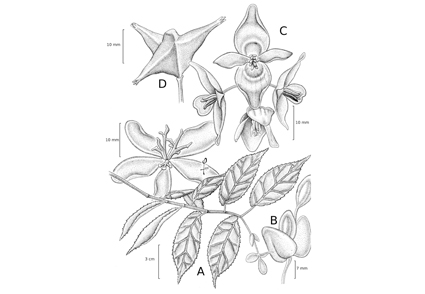Abstract
Casparya, one of the most species-rich sections of Begonia in the Neotropics with 44 species, is distributed from Costa Rica to Peru, with the highest diversity in the Colombian Andes. The section is morphologically well-differentiated and can be distinguished from other Andean cane-like begonias by the 3-horned fruit and multifid or un-divided styles. Here we describe eight taxonomic novelties for Casparya from Colombia, five species and three varieties, descriptions include illustrations, distribution maps, taxonomic comments, and assessments of conservation status. The five species described here are: Begonia diegoi, Begonia galeanoi, Begonia mamapachensis, Begonia perijaensis, and Begonia vinagrera; and the three new varieties are: Begonia kalbreyerii var. orquidensis, Begonia silverstonei var. brevipetiolata, and Begonia vinagrera var. pomecensis. We also present a taxonomic key for the 32 species of Casparya so far known from Colombia.
References
<p>Armenteras, D., Gast, F. & Villareal, H. (2003) Andean forest fragmentation and the representativeness of protected natural areas in the eastern Andes, Colombia. <em>Biological conservation</em> 113: 245–256. https://doi.org/10.1016/S0006-3207(02)00359-2</p>
<p>Bachman, S., Moat, J., Hill, A.W., De La Torre, J. & Scott, B. (2011) Supporting Red List threat assessments with GeoCAT: geospatial conservation assessment tool. <em>ZooKeys</em> 150: 117–126. https://doi.org/10.3897/zookeys.150.2109</p>
<p>Bentham, G. (1845) <em>Plantas Hartwegianas imprimis Mexicanas</em>. G. Pamplin, London, 393 pp.</p>
<p>Cuatrecasas, J. (1958) Aspectos de la Vegetación Natural de Colombia. <em>Revista de la Academia Colombiana de Ciencias Exactas, Físicas y Naturales</em> 10: 221–261.</p>
<p>De Candolle, C. (1908) Begoniaceae Novae. <em>Bulletin de l’Herbier Boissier</em> 8: 309–328.</p>
<p>De Lange, A. & Bouman, F. (1999) Seed micromorphology of neotropical begonias. <em>Smithsonian Contributions to Botany </em>90: 1–49. https://doi.org/10.5479/si.0081024X.90</p>
<p>Decraene, L.R. & Smets, E. (1990) The Systematic Relationship between Begoniaceae and Papaveraceae: A Comparative Study of Their Floral Development. <em>Bulletin du Jardin botanique national de Belgique/Bulletin van de Nationale Plantentuin van Belgie</em> 60: 229–273. https://doi.org/10.2307/3668215</p>
<p>Dewitte, A., Twyford, A.D., Thomas, D.C., Kidner, C.A. & Van, J. (2011) The Origin of Diversity in Begonia: Genome Dynamism, Population Processes and Phylogenetic Patterns. <em>In</em>: Grillo, O. & Venora, G. (Eds.) <em>The Dynamical Processes of Biodiversity - Case Studies of Evolution and Spatial Distribution</em>. Tech Open Access, pp. 27–52. https://doi.org/10.5772/23789</p>
<p>Doorenbos, J., Sosef, M.S.M. & De Wilde, J.J.F.E. (1998) <em>The sections of Begonia including descriptions, keys and species lists</em>. Wageningen Agricultural University, Wageningen, 264 pp.</p>
<p>Etter, A. & Villa, L.A. (2000) Andean forests and farming systems in part of the Eastern Cordillera (Colombia). <em>Mountain Research and Development</em> 20: 236–245. https://doi.org/10.1659/0276-4741(2000)020[0236:AFAFSI]2.0.CO;2</p>
<p>Faegri, K. & Van Der Pijl, L. (1979) <em>The principles of pollination ecology</em>. Pergamon press, Oxford, 244 pp. https://doi.org/10.1016/B978-0-08-023160-0.50020-7</p>
<p>Fundación Prosierra Nevada de Santa Marta (1991) <em>Historia y Geografía, Sierra Nevada de Santa Marta</em>. Fondo Editorial Prosierra Nevada de Santa Marta, Bogotá, 47 pp.</p>
<p>Hernandez-Camacho, J. & Sanchez-P., H. (1992) Biomas terrestres de Colombia. <em>In: </em>Halfter, G. (Ed.) <em>La diversidad biológica de Iberoamérica I. </em>Volumen Especial, Acta Zoológica Mexicana, nueva serie, Instituto de Ecología, Xalapa, pp. 153–174.</p>
<p>International Union for Conservation of Nature (IUCN) (2012) <em>IUCN Red List Categories and Criteria: Version 3.1. </em>International Union for Conservation of Nature, Gland and Cambridge, iv + 32 pp.</p>
<p>Jara-Muñoz, O.A. (2016) Two new species of <em>Begonia</em> (Begoniaceae) from the Colombian Western Cordillera. <em>Phytotaxa</em> 257 (1): 81. https://doi.org/10.11646/phytotaxa.257.1.6</p>
<p>Jara-Muñoz, O.A., Richardson, J.E. & Madriñan, S. (2019) Character evolution and recircumscription of the northern Andean <em>Begonia</em> section <em>Casparya</em> (Begoniaceae). <em>Systematic Botany</em> 44: 52–65. https://doi.org/10.1600/036364419X697895</p>
<p>Klotzsch, J.F. (1854) Ordo Begoniaceae R. Brown, Bonpland. <em>Bericht über die zur Bekanntmachung geeigneten Verhandlungen der Königlich Preussischen Akademie der Wissenschaften zu Berlin</em> 2 March: 121–128.</p>
<p>Lazala, M. (2007) Geología. <em>In</em>: Rangel-CH, O. (Ed.) <em>Colombia diversidad biótica V. la alta montaña de la serranía de Perijá</em>. Instituto de Ciencias Naturales, Bogotá D.C., pp. 43–61.</p>
<p>Linnaeus, C. (1781) <em>Supplementum Plantarum</em>. Orphanotrophe, Brunswig, 468 pp.</p>
<p>Linnaeus, C. von (1753) <em>Species Plantarum</em>. Imprensis Laurentii Salvii, Holmiae, 1056 pp.</p>
<p>Moonlight, P.W., Ardi, W.H., Padilla, L.A., Chung, K.-F., Fuller, D., Girmansyah, D., Hollands, R., Jara-Muñoz, A., Kiew, R., Leong, W.-C., Liu, Y., Mahardika, A., Marasinghe, L.D.K., O′Connor, M., Peng, C.-I., Pérez, Á.J., Phutthai, T., Pullan, M., Rajbhandary, S., Reynel, C., Rubite, R.R., Sang, J., Scherberich, D., Shui, Y.-M., Tebbitt, M.C., Thomas, D.C., Wilson, H.P., Zaini, N.H. & Hughes, M. (2018) Dividing and conquering the fastest-growing genus: towards a natural sectional classification of the mega-diverse genus <em>Begonia</em> (Begoniaceae). <em>Taxon</em> 67: 267–323. https://doi.org/10.12705/672.3</p>
<p>Rangel-Ch., O. (Ed.) (2009) <em>Colombia diversidad biótica VIII. Media y baja montaña de la serranía de Perijá</em>. Instituto de Ciencias Naturales, Bogotá D.C., 728 pp.</p>
<p>Reina, M., Medina, R., Ávila, F.A., Ángel, S.P. & Cortés, R. (2010) Catálogo preliminar de la flora vascular de los bosques subandinos de la reserva biológica Cachalú, Santander (Colombia). <em>Colombia forestal</em> 13: 27–54. https://doi.org/10.14483/udistrital.jour.colomb.for.2010.1.a02</p>
<p>Rodriguez, L.M. & Galán, C. (2008) Las zonas kársticas de la Serranía de Perijá, Venezuela: cavidades estudiadas y rasgos geológico-estrucurales. <em>Boletín de la Sociedad Venezolana de Espeleología</em> 42: 7–19.</p>
<p>Shorthouse, D.-P. (2010)<em> SimpleMappr, an online tool to produce publication-quality point maps</em>. Available from: https://www.simplemappr.net (accessed 26 January 2021)</p>
<p>Smith, L.B. & Schubert, B.G. (1946) The Begoniaceae of Colombia. <em>Caldasia</em> 4: 18–20.</p>
<p>Smith, L.B. & Schubert, B.G. (1952) Plants collected in Ecuador by W. H. Camp. Begoniaceae. <em>Memoirs of The New York Botanical Garden</em> 8: 36–40.</p>
<p>Smith, L.B. & Schubert, B.G. (1955) Studies in the Begoniaceae, IV. <em>Journal of the Washington Academy of Sciences</em> 45: 110–114.</p>
<p>Thiers, B. (2021) Index herbariorum: a global directory of public herbaria and associated staff. New York Botanical Garden’s virtual herbarium. Available from: http://sweetgum.nybg.org/science/ih/ (accessed 26 January 2021)</p>
<p>Vásquez, V.H. & Serrano, M.A. (2009) <em>Las áreas protegidas de Colombia</em>. Conservación Internacional-Colombia & Fundación Biocolombia, Bogotá, 969 pp.</p>
<p>Warburg, O. (1894) Begoniaceae. <em>In</em>. Engler, A. & Prantl, K.A. (Eds.) <em>Die Natürlichen Pflanzenfamilien</em>. Wilhem Engelmann, Leipzig, pp. 121–150.</p>


